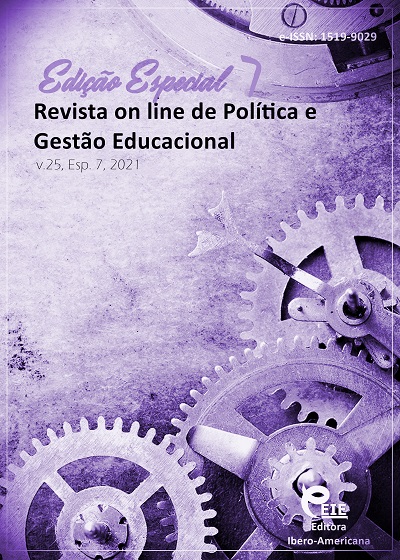O efeito da educação de artesanato nas relações de vida urbana
DOI:
https://doi.org/10.22633/rpge.v25iesp.7.16185Palavras-chave:
Artesanato, Relações da vida urbana, Cidadãos de teerãResumo
Como uma indústria independente e nativa, a arte aplicada mais proeminente do Irã e um dos três principais polos de artesanato do mundo, o artesanato do Irã está profundamente enraizado na cultura rica e fértil do Irã islâmico. Trata-se de um estudo aplicado realizado por meio de método exploratório e misto (qualitativo-quantitativo). A população estatística incluiu todos os indivíduos que visitaram os centros de arte de Teerã, Irã em 2019 e também pessoas que educaram nesta área. Os sujeitos foram selecionados por amostragem estratificada em múltiplos estágios e amostragem por conveniência por meio de entrevistas. Um questionário de 18 itens com dimensões cognitivas, culturais e sociais foi elaborado com base em dados obtidos em entrevistas e fundamentação teórica. De acordo com os resultados, a revitalização e promoção do uso do artesanato afetou todos os três componentes das relações de vida urbana. De acordo com os resultados da análise de regressão, a revitalização e promoção do artesanato afetaram 23%, 23% e 19% dos componentes cognitivos, culturais e sociais das relações de vida urbana, respectivamente.
Downloads
Referências
BAZARGAN, A. Introduction to Qualitative and Mixed Research Methods, Tehran, Didar Publications, Tehran, Iran, 2008.
BODENHAM, P. Ceramics and locational identity: Investigating the symbolism of material culture in relation to a sense of place. Craft Research, v. 9, n. 2, p. 287-310, 2018.
CARBALLO, D. M. Urban life on Teotihuacan's periphery–new research at the Tlajinga district. Ancient Mesoamerica, v. 30, n. 1, p. 91-94. 2019.
FATHI, S. An Analysis of Social Relations in Sustainable Urban Space. Journal of Iranian Social Development Studies, v. 4, n. 4, p. 47-67. 2012.
FISHER, K. D.; MANNING, S. W.; URBAN, T. M. New Approaches to Late Bronze Age Urban Landscapes on Cyprus: Investigations at Kalavasos-Ayios Dhimitrios, 2012–2016. American Journal of Archaeology, v. 123, n. 3, p. 473-507, 2019.
GOLDING, R. Freud, Psychoanalysis, and Sociology: Some Observations on the Sociological Analysis of the Individual. The British Journal of Sociology, v. 33, n. 4, p. 545, 1982.
OWENS, B. R. Producing Parsons’ Reputation: Early Critiques of Talcott Parsons’ Social Theory and the Making of a Caricature. Journal of the History of the Behavioral Sciences, v. 46, n. 2, p. 165–188, 2010.
PARSONS, T. The Social System. New York and London: The Free Press and Collier Macmillan, 1951.
PARSONS, T. 'The prospect of sociological theory', reprinted in Essays in Sociological Theory. New York, Free Press, 1954.
PARSONS, T.; BALES, R. F. Family, Socialization and Interaction. New York and London: The Free Press and Collier Macmillan, 1955.
PRINCE, S. Dwelling and tourism: embracing the non-representational in the tourist landscape. Landscape Research, 2018.
SALEHI AMIRI, S. R. Cultural Pathology in Iran. 1. ed. Qoqnoos Publications, Tehran, Iran. 2013.
SEDREHNESHIN, R. et al. The Survey of the Handcraft's Application Reduction Factors in Contemporary Life in Functionalism Theory. 2016. Thesis (Master’s in Handicrafts) – School of Art, Al-Zahra University, 2014.
WOOD, G. L.; HABER, J. Nursing research. St. Louis: Mosby Co, 20002.
XIE, B.; ZHU, X.; GRYDEHØJ, A. Perceiving the Silk Road Archipelago: Archipelagic relations within the ancient and 21 st-Century Maritime Silk Road. Island Studies Journal, v. 15, n. 2, 2020.
Downloads
Publicado
Como Citar
Edição
Seção
Licença
Copyright (c) 2022 Revista on line de Política e Gestão Educacional

Este trabalho está licenciado sob uma licença Creative Commons Attribution-NonCommercial-ShareAlike 4.0 International License.
Manuscritos aceitos e publicados são de propriedade da Revista on line de Política e Gestão Educacional. É vedada a submissão integral ou parcial do manuscrito a qualquer outro periódico. A responsabilidade do conteúdo dos artigos é exclusiva dos autores. É vedada a tradução para outro idioma sem a autorização escrita do Editor ouvida a Comissão Editorial Científica.











